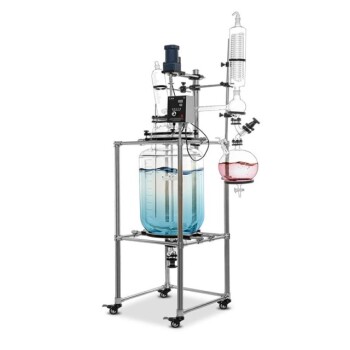A rotary evaporator, or rotovap, is a sophisticated laboratory instrument designed for the efficient removal of solvents from samples through evaporation. It consists of several key components that work together to facilitate this process. These include a heated water bath, a rotating evaporation flask, a vacuum pump, a condenser, and a receiving flask. Each part plays a crucial role in ensuring the effective separation and collection of solvents. Understanding the function and importance of each component is essential for optimizing the use of a rotovap in various laboratory applications.
Key Points Explained:

-
Heated Water Bath:
- Function: The heated water bath is used to regulate the temperature of the sample in the evaporation flask. By maintaining a consistent temperature, it ensures that the solvent evaporates at a controlled rate.
- Importance: Proper temperature control is crucial for preventing the degradation of heat-sensitive compounds and ensuring efficient evaporation.
-
Rotating Evaporation Flask:
- Function: The evaporation flask contains the mixture to be separated. It is rotated by a motor to increase the surface area of the liquid, promoting even heating and faster evaporation.
- Importance: Rotation helps in achieving uniform evaporation and prevents the formation of hot spots, which can lead to uneven heating and potential sample degradation.
-
Vacuum Pump:
- Function: The vacuum pump reduces the pressure within the system, which lowers the boiling point of the solvent. This allows for evaporation at lower temperatures, which is particularly beneficial for heat-sensitive samples.
- Importance: Lowering the boiling point minimizes the risk of thermal decomposition and allows for the gentle removal of solvents.
-
Condenser:
- Function: The condenser cools and recondenses the evaporated solvent into a liquid form. It is typically chilled using a cooling medium such as water or a refrigerant.
- Importance: Efficient condensation is essential for the recovery of the solvent and prevents its loss to the environment.
-
Receiving Flask:
- Function: The receiving flask collects the recondensed solvent from the condenser. It is positioned to allow easy collection and measurement of the distilled solvent.
- Importance: Accurate collection and measurement of the solvent are crucial for quantitative analysis and further use of the solvent.
-
Motor Unit:
- Function: The motor unit rotates the evaporation flask, ensuring even distribution of heat and promoting efficient evaporation.
- Importance: Consistent rotation is key to achieving uniform evaporation and preventing sample degradation.
-
Vapor Duct:
- Function: The vapor duct connects the evaporation flask to the condenser, allowing the vaporized solvent to travel from the flask to the condenser.
- Importance: A properly designed vapor duct ensures efficient transfer of vapor and minimizes the risk of leaks or pressure drops.
-
Pressure Measuring Part:
- Function: This component measures the pressure within the system, allowing for precise control and monitoring of the vacuum level.
- Importance: Accurate pressure measurement is essential for maintaining the desired vacuum level, which directly affects the evaporation rate and efficiency.
-
Protective Components:
- Function: Protective components include safety features such as bump traps and glass tubes that prevent sample loss and protect the system from contamination.
- Importance: These components ensure the safety and integrity of the system, preventing accidents and contamination of the sample.
-
Motorized Mechanism to Lift the Evaporation Flask:
- Function: This mechanism allows for the easy lifting and lowering of the evaporation flask, facilitating the setup and removal of samples.
- Importance: This feature enhances the usability and convenience of the rotovap, making it easier to handle and operate.
Understanding these components and their functions is essential for the effective use of a rotary evaporator. Each part plays a vital role in the overall process, and proper maintenance and operation of these components are crucial for achieving optimal results in laboratory applications.
Summary Table:
| Component | Function | Importance |
|---|---|---|
| Heated Water Bath | Regulates temperature for controlled evaporation | Prevents degradation of heat-sensitive compounds |
| Rotating Evaporation Flask | Increases surface area for uniform heating and faster evaporation | Ensures even evaporation and prevents hot spots |
| Vacuum Pump | Reduces pressure to lower boiling points for gentle solvent removal | Minimizes thermal decomposition |
| Condenser | Cools and recondenses evaporated solvent | Recovers solvent efficiently |
| Receiving Flask | Collects and measures recondensed solvent | Essential for quantitative analysis |
| Motor Unit | Rotates the evaporation flask for even heat distribution | Prevents sample degradation |
| Vapor Duct | Transfers vapor from the flask to the condenser | Ensures efficient vapor transfer |
| Pressure Measuring Part | Monitors and controls system pressure | Maintains optimal vacuum levels for evaporation |
| Protective Components | Includes safety features like bump traps and glass tubes | Prevents sample loss and contamination |
| Motorized Lift Mechanism | Facilitates easy lifting and lowering of the evaporation flask | Enhances usability and convenience |
Optimize your lab's solvent removal process with a rotary evaporator—contact our experts today for more information!

















